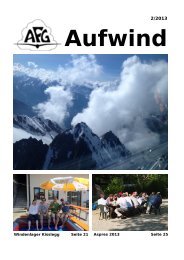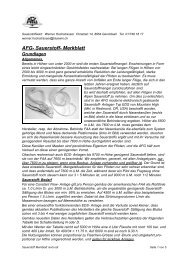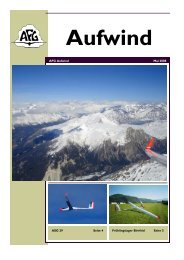Filser Electronic G
Filser Electronic G
Filser Electronic G
Create successful ePaper yourself
Turn your PDF publications into a flip-book with our unique Google optimized e-Paper software.
page 20<br />
LX5000 March 2002<br />
TE setting 0% declares compensation using the TE tube<br />
Using the tube the instrument has no influence on compensation; it depends only on the quality of the tube.<br />
TE setting >0% = electronic TE compensation<br />
To adjust TE composition at least one flight in not turbulent atmosphere is necessary. The procedure is as follows:<br />
• Accelerate up to 160 km/h and keep the speed stable for a few seconds<br />
• Reduce the speed to 80 km/h<br />
Observe the vario indicator during the maneuver. At the beginning (160 km/h) vario will stay stable aty about. –2 m/s.<br />
During the speed reduction the vario should move toward zero and should never exceed zero. Deviation in + shows that<br />
the compensation is too low, increase % to compensate and vice versa.<br />
TEF (filter) is the delay of compensation. Bigger numbers will increase the delay and opposite. During the first test one<br />
should use delay 6.<br />
If the static of the glider isn’t correct, there is no way to adjust compensation. Having problems we suggest the following<br />
test of the static inputs:<br />
Connect the tubes for the electronic compensation and set at 0%. Accelerate to 160 km/h and reduce the speed. Observe<br />
the vario indicator. If the needle is moving at first more into minus and after that towards +, the static source of the<br />
glider is not suited and there is no way to provide a successful TE compensation electronically. The use of a dedicated<br />
and accurate fin mounted static source might be helpful.<br />
3.1.2.13 AUDIO<br />
The pilot has several choices to adapt the audio to his preference.<br />
• SC: VOL H audio volume will be increased by speed command (H) or decrease by ( L)<br />
• VARIO: several types of audio can be selected (please use AUDIO DEMO)<br />
• 0% frequency at 0 m/s<br />
• +100% frequency at + full deflection<br />
• -100% frequency at – full deflection<br />
3.1.2.14 INPUT (Speed command external switch)<br />
The LX5000 has input for an external speed command switch. Using the external switch it is possible to manually<br />
change over SC/Vario. SC INPUT setting defines what status of the switch will change over to speed command. For<br />
instance ON will change over to speed command immediately after the external switch is closed and vice versa.<br />
An external device called stall warning can be connected to the LX5000. The indicated speed, to activate the alarm, can<br />
be set under STALL W.<br />
The LX5000 is equipped with an external temperature sensor. Temperature ON will enable temperature measurement







